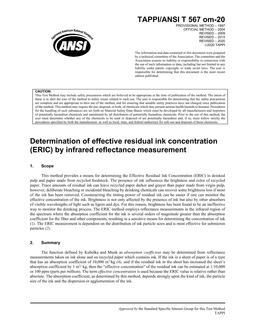
TAPPI T 567 om-20
- Comments Off on TAPPI T 567 om-20
- TAPPI
This method provides a means for determining the Effective Residual Ink Concentration (ERIC) in deinked pulp and paper made from recycled feedstock. The presence of ink influences the brightness and color of recycled paper. Trace amounts of residual ink can leave recycled paper darker and grayer than paper made from virgin pulp, however, deliberate bleaching or incidental bleaching by deinking chemicals can recover some brightness loss if most of the ink has been removed. Counteracting the tinting power of residual ink can be easier if one can monitor the effective concentration of the ink. Brightness is not only affected by the presence of ink but also by other absorbers of visible wavelengths of light such as lignin and dye. For this reason, brightness has been found to be an ineffective way to monitor the deinking process. The ERIC method employs reflectance measurements in the infrared region of the spectrum where the absorption coefficient for the ink is several orders of magnitude greater than the absorption coefficient for the fiber and other components, resulting in a sensitive means for determining the concentration of ink (1). The ERIC measurement is dependent on the distribution of ink particle sizes and is most effective for submicron particles (2).
Product Details
- Published:
- 2020
- Number of Pages:
- 6
- File Size:
- 1 file , 300 KB

